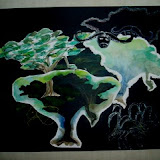Flying Pygmies and Electrical Storms in Dogon Country
Aug 5-8, 2004
I write this while sitting on my thermarest chair on the mud roof of a small ‘campement’ in a Dogon village in Mali. Dogon country is (deservedly) a UNESCO world heritage site. The Dogon built their houses, granaries, and worship places high up on the steep edge of the cliffs of Mali. The cliffs or ‘Falaise’, rises up dramatically for a 200km stretch out of the sahelian plains of southern Mali.
Beside the small mud houses and granaries, one can see very small structures with windows- some so small they could be large bird nests. These tiny places were alleged to be the homes of the Tellem people (pygmies), who were displaced by the Dogon and fled to central Africa. Tradition also claims that the early Dogon had magical power, and could fly, or transmit their bodies from plain to cliff. Otherwise it is an extremely inconvenient place to live!
Dogon wise men called ‘Hogons’ lived in these cliff dwellings. Once they were chosen, they would go up to live in the cliffs and never come down again. The Hogon could only eat food prepared by a virgin girl, and they were not allowed to wash. According to Dogon mythology, a snake- sacred animal for the Dogon- would come each night and lick the Dogon clean.
The Dogon still live in villages that dot the top of the Falaise, and along the base. They still make their houses out of a mud and stone mix.
The mosques in this part of West Africa have a unique and stunning architecture. They are constructed with the same red earth as the houses and granaries. Soft edged cones surround the walls and lead up to a central spire in a pyramid shape. Large pieces of wood sticking out of the walls facilitate reconstruction after each rainy season.
Typical of Sahelian West Africa, the village people greet visitors graciously. Children with the most engaging smiles play freely around the village, women continue in an unending flow of exhausting work, and old men sit under the Togu-na to pass the time of day.
The Togu-na is a low structure with large rocks or beautifully carved wooden posts supporting a low thick thatch roof. This is where the Dogon elders pass judgment on village disputes. An example of traditional West African mediation practices, the low roof means that the contrary parties can’t stand up, and so they are physically constrained to discuss rather than to fight.
At the charming campement at the base of the cliff, we were treated to a late-night Malian jam session. Malian music is the root of American blues; it still produces some of the best music in Africa. This soirée was lead by an awesome blues guitarist and accompanied by jembé drum, whistle, and a traditional stringed instrument that was once a goat.
One night we stayed in a village on the top of the Falaise. The village is built on a high, flat rocky projection with steep cliffs on three sides, and a rock peak on the fourth. This location provides a 300 degree view of the cliffs and sandstone pillars across the ravine. A wild electrical storm came in the night we were there. I took my thermarest chair and sat alone in the dark outside the village on a huge sandstone slab, and watched the storm slowly gather force in the deepening night.
Lightening started soundlessly in one darkening corner of the sky, and swiftly spread to surround us. Ragged flashes came from all directions, and for brief seconds would light up the whole sky, revealing the craggy sandstone rock formations and peaks close by. In between flashes the world was completely black. After a half hour of this spectacular light show, the audible elements joined in. Thunder started a slow tympanic grumble in the distance, then came a howling strong wind carrying dust from the Sahel, and finally, with a sense of relief, crashing rains. In my head the orchestra played full blast.
Monday, January 03, 2005
Subscribe to:
Post Comments (Atom)

No comments:
Post a Comment